Wednesday 8th of May 2024
Wednesday 8th of May 2024
The history of Kegworth Carnival is a history of the village 'wakes'. The original focal point of this event was in the Market Place with stalls stretching to Borough Street and down London Road as far as Dump Lane (now Whatton Road). Donkey rides were offered from the Three Cranes Inn to the Britannia along what is now the A6. The various sick clubs had their annual parade, headed by the Village Band resplendent in blue and gold uniforms.
From 1928 until the outbreak of war the Carnival was organised by Kegworth Hospital Association and raised an average of £200 every year for hospitals in the surrounding region, including Loughborough, Derby, Nottingham and Leicester. The Carnivals were characterised by the Grand Parade which made its way through the village down to Hallstone Meadow. The Loughborough Echo of 27 July 1928 records the Kegworth Hospital Fete on the 21st July , starting with a fancy dress parade marching through the village headed by the Kegworth Band. Decorated floats included such titles as Wedding Party, Nursery Rhyme, Kegworth at the Seaside and The Mustard Club. A film was made and the next issue of the Loughborough Echo reports 'Great interest in cinematography pictures of Hospital Fete procession which are being shown at Kegworth Picture House'.
It is evident that in the earliest years of the Hospital Fete, the venue for some of the activities was the Manor House. The report dated August 1928 in the Loughborough Monitor describes the circuitous route of the parade through the streets ending up at the Manor House where the judging took place. There were 20 decorated drays with tableaux depicting such subjects as Peace, Bubbles and an Irish Market Day.
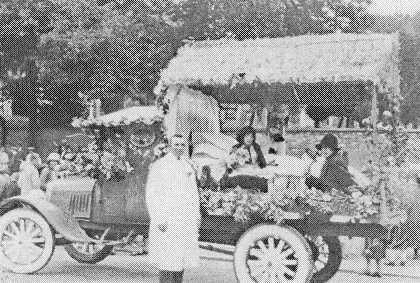
The first Kegworth Carnival, 1928. The carnival queen that year was Miss Cran.
The procession was headed by Kegworth Brass Band, followed by members of the British Legion, RAOB and Oddfellows in their insignias. Stalls were manned by the Women's Institute and the employees of Harry R. Hopewell, while teas in the Parish Room in Mill Lane were served by the employees of Messrs. Yates. The last Hospital Fete was held in 1939, when Lady Belper crowned the Carnival Queen, Miss Lucy Large.
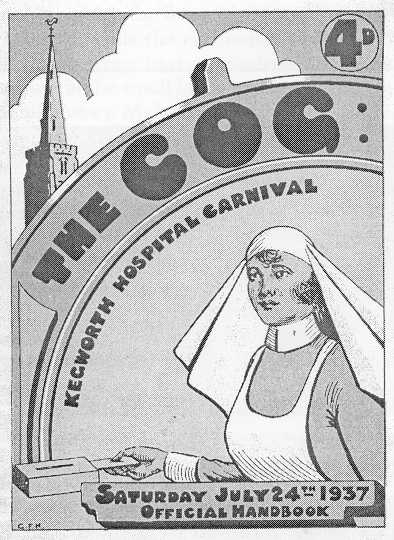
The cover design for this pre-war carnival programme remained almost unchanged for a number of years.
A committee was formed in 1949 under the auspices of the British Legion to revive Kegworth Carnival and the first post war Carnival was held in 1950. The Chairman of the Committee was Mr Tom A. Groves, the Secretary Miss Brenda Bassett assisted by Mr Norman Brown and Mr Harold Mellors. The Editor of the programme, called The Cog, was Mr George R Hudson.
The publication was more akin to a village magazine than to a programme, freely illustrated with drawings of the participants by Mr Hudson (a prolific artist). It cost 1/- and included an excellent map of the village drawn by Mr Henry Vercoe. The President of the enterprise was Mr William Powell Heath who lived at The Wymeshead.
The Carnival was an immediate success, drawing a crowd of about 3000 people in the first few years, which grew to double that number by 1957. In 1954 the Committee pioneered the first traction engine rally in the Midlands, enthusiastically organised by Mr Norman Brown. That, together with the traditional Horticultural Show; organised by Mr Harold Smith, provided the backbone of the Kegworth post-war Carnivals. But numerous additional entertainments came and went: tug of war, high divers, trick motor cyclists, vintage car rallies - all had their place. A regular feature was a competition run by the Carnival Band Association.
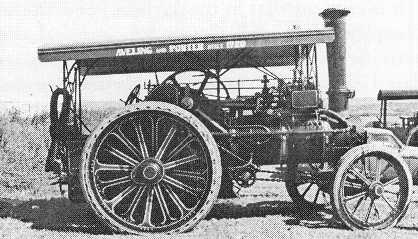
In 1957, the traditional Ox Roasting, which had been a feature of the pre-war Carnivals, was restored. The first Ox Roast had taken place in 1929 under the supervision of Mr C. Gardiner of Stratford, assisted by Mr C. Hall of Jeffares Close. In 1957, Mr Norman Brown won £100 on the TV programme "State Your Case" for an ox in order to continue the tradition of Ox Roasting at Kegworth. In 1957 and 1958 the proceedings were supervised by Mr Tyler of Stratford, but he died in 1959 and one week before the Carnival there was no-one to take charge and no equipment. Mr Dick Sibson and a band of willing helpers decided that they would 'have a go'. They hired the equipment for roasting, and despite some anxious moments were successful.
In 1960 the team decided to design and build their own equipment and were fortunate in being able to use the workshop facilities provided by Mr William E. Bryan. The new design proved to be a great advance and had a number of unique features. The ox, which weighed about 10cwt (live) was killed on the Thursday before the Carnival and delivered to the meadow on Friday night when it was poled and secured. It was guarded throughout the night. At 5-30 am on Saturday the team arrived to build the hearth, the positioning of which depended on the direction and strength of the wind.
The hearth was formed by 25cwt of sand, the sides by 1400 bricks. The fire was fed by four bags of logs and a ton of coal, and the first slice was cut about four hours after roasting commenced. About 1800 baps or cobs were prepared and filled with the sliced meat for which there was always a ready sale. In the 1980s when the price of an ox became too great an outlay, the Ox Roast was sponsored by the National Westminster Bank through its connection with Kegworth and the Computer Centre.
The Carnival was always held on the last Saturday in July but in 1962 it became a two day event. The Carnival Queen was crowned at the opening of the event on the Saturday. Attired in a royal robe, the Queen was attended by two young ladies and by two page boys, and arrived at the Meadow at the head of the parade in a float. On the Sunday, the proceedings began with an open air service led by the Rector and the other ministers in the village.
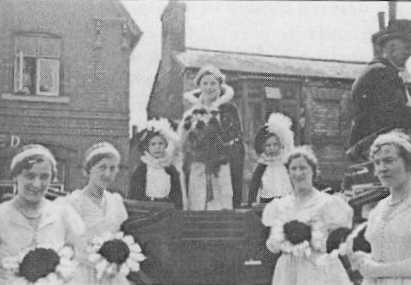
Carnival Queen Winnie Poxon in her carriage with two pageboys. Her attendants were Nancy Temple, Lillie Hinds, Freda Baxter and Hilda Shillcross. Miss Poxon sadly died of meningitis on 22 April 1937, the year after her coronation.
When the Carnival was restarted in 1950, it was not expected that a great deal of profit would be made, but from this time the Committee supported the benevolent work of the British Legion and arranged for gifts of groceries to the elderly of the village at Christmas time. As the popularity of the Carnival grew and larger surpluses were made, the committee made gifts of money to local good causes, particularly the Village Hall, the Welcome Club, the Scouts and St John Ambulance. In the early 1970s, the Carnival itself became a registered Charity, with the express purpose of raising funds for charitable work in Kegworth. Tribute must be made to the hard work of the organising committee throughout the year to make it such a success.
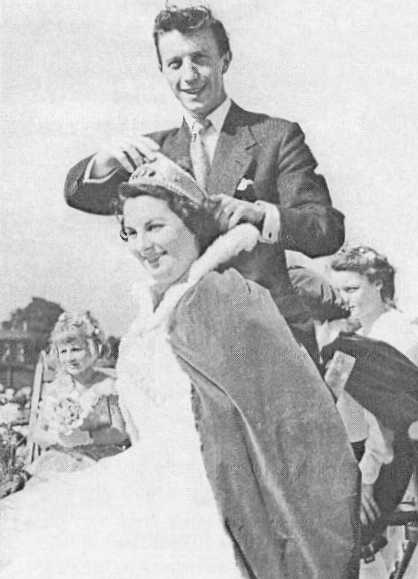
The silver screen comes to Kegworth carnival in 1952. The Carnival Queen, Ruby Whitehurst (nee Chaplin), is crowned by Harry Fowler a successful British actor who appeared in 65 films, including Hue and Cry and The Pickwick Papers, between 1942 and 1990.
Following its revival, the Carnival was held on Hallstone Meadow every year except in 1960 and 1961 when it moved to Kingston Fields just over the border in Nottinghamshire. HaIlstone Meadow belonged to Mr and Mrs Ernest White, without whose generous co-operation the 19th could not have been staged.

The last Carnival was held on 29 and 30 July, 1989, after which the Meadow was no longer available, and the Committee was unable to find a suitable site to house the large number of vehicles and steam engines which attended the rally: It was reluctantly decided to wind up the Charity and to distribute the remaining funds to those causes which had been supported over the preceding 39 years. Over this span of time approximately £60,000 had been raised and distributed. In addition to this a large number of village organisations took stalls on the Carnival field from which they derived money to support their various endeavours.
Despite a number of wet days, when sometimes the ground was so wet that cars had to be winched out of the mud by a traction engine, and owing to much hard work by so many citizens of Kegworth, it had all been worthwhile.

Kegworths B & MA Johnson still give us a flavour of Carnival times past when "Winifred George" comes out steaming in the summer.
Shall we ever see an event, such as the Carnival, in Kegworth again?
All the fun of the carnival in a lively panoramic drawing made by F.R. Shaw in 1988. The scene depicted is in Hallstone Meadow with boats moored at the river bank, and a lady at the extreme right apparently about to take a swim! The ox roast is taking place in the centre of the picture, on the purpose-built hearth described in this chapter, while on the left a high wire artist seems to run the risk of being roasted by the traction engine in the arena below. Perhaps the fuchsia Kegworth Carnival, raised by Harold Smith is on show in one of the exhibition marquees in the middle distance. Side shows, a roundabout, steam organ, two bands, dancing girls, donkey rides, and yet more traction engines, full size and miniature, are all included, set off by the characteristic Soar Valley backdrop of cooling towers, power lines and pylons.